Forex trading, also known as foreign exchange trading, is a global marketplace where currencies are bought and sold. It’s a dynamic arena that offers immense opportunities for individuals seeking to expand their financial portfolios. However, diving into forex trading without a solid understanding can be overwhelming for beginners. This comprehensive guide aims to demystify forex trading, providing beginners with essential knowledge, strategies, and tips to navigate the markets successfully.
Forex Trading:
Forex trading involves the buying and selling of currencies in the foreign exchange market. Unlike stock markets, forex operates 24 hours a day, five days a week, making it highly accessible to traders worldwide. The primary objective of forex trading is to profit from fluctuations in currency prices. Traders speculate on whether a currency will strengthen or weaken relative to another, aiming to capitalize on these price movements.
Key Concepts for Beginners:
1. Currency Pairs: In forex trading, currencies are always traded in pairs, such as EUR/USD or GBP/JPY. Each pair consists of a base currency and a quote currency, with the exchange rate indicating how much of the quote currency is needed to purchase one unit of the base currency.
2. Leverage: Leverage allows traders to control a larger position size with a smaller amount of capital. While leverage amplifies potential profits, it also increases the risk of losses, making risk management crucial.
3. Bid and Ask Prices: The bid price refers to the price at which traders can sell a currency pair, while the ask price is the price at which they can buy. The difference between the two prices is known as the spread, representing the broker’s profit.
4. Market Analysis: Fundamental and technical analysis are fundamental tools for forex traders. Fundamental analysis involves evaluating economic indicators, geopolitical events, and central bank policies, while technical analysis relies on price charts and patterns to predict future price movements.
Getting Started with Forex Trading:
1. Educate Yourself: Before diving into forex trading, invest time in learning the fundamentals, terminology, and market dynamics. Numerous online resources, courses, and books are available to help beginners gain knowledge and confidence.
2. Choose a Reliable Broker: Selecting the right forex broker is essential for a smooth trading experience. Consider factors such as regulation, trading platforms, spreads, commissions, and customer support before making a decision.
3. Develop a Trading Plan: A trading plan outlines your trading goals, risk tolerance, strategies, and money management rules. Having a well-defined plan helps you stay disciplined and focused during volatile market conditions.
4. Start with a Demo Account: Most brokers offer demo accounts where you can practice trading with virtual funds in a risk-free environment. Use this opportunity to familiarize yourself with the trading platform and test different strategies before risking real money.
5. Practice Risk Management: Protect your capital by implementing risk management strategies such as setting stop-loss orders, diversifying your trades, and avoiding over-leveraging positions.
Effective Forex Trading Strategies:
1. Trend Following: This strategy involves identifying and trading in the direction of the prevailing market trend. Traders use technical indicators such as moving averages and trendlines to spot trends and enter trades accordingly.
2. Breakout Trading: Breakout traders aim to capitalize on significant price movements that occur when the price breaks above or below a key support or resistance level. This strategy requires patience and the ability to act swiftly when a breakout occurs.
3. Range Trading: Range-bound markets exhibit sideways price movement between established support and resistance levels. Range traders buy at support and sell at resistance, profiting from price oscillations within the range.
4. Carry Trade: The carry trade strategy involves borrowing funds in a low-interest-rate currency and investing in a higher-yielding currency, profiting from the interest rate differential. However, carry trades are exposed to currency fluctuations and interest rate changes.
Conclusion:
Forex trading offers a world of opportunities for beginners willing to learn, adapt, and persevere. By understanding the fundamentals, developing a solid trading plan, and implementing effective strategies, beginners can navigate the forex markets with confidence and success. Remember, forex trading is not a get-rich-quick scheme but a journey that requires patience, discipline, and continuous learning. With dedication and perseverance, beginners can unlock the potential of forex trading and achieve their financial goals.
FAQ
Q: Is forex trading risky?
A: Yes, forex trading carries inherent risks due to market volatility, leverage, and geopolitical factors. However, with proper education, risk management, and discipline, traders can mitigate risks and enhance their chances of success.
Q: How much money do I need to start forex trading?
A: The amount of capital required to start forex trading varies depending on your trading style, risk tolerance, and broker’s requirements. Some brokers offer micro or mini accounts with low initial deposits, allowing beginners to start trading with a small amount of capital.
Q: Can I trade forex part-time?
A: Yes, forex trading offers flexibility, allowing traders to participate in the markets part-time while maintaining other commitments. However, successful trading requires dedication, discipline, and the ability to adapt to changing market conditions.
Q: How can I improve my forex trading skills?
A: Continuous learning, practice, and self-reflection are essential for improving forex trading skills. Engage in online courses, attend webinars, analyze your trades, and seek feedback from experienced traders to enhance your knowledge and expertise.




